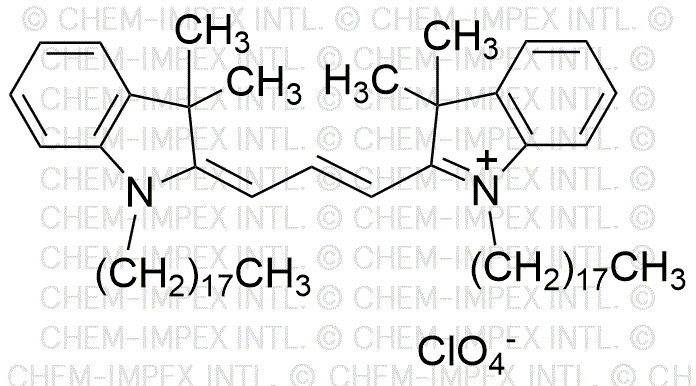1,1'-Dioctadecyl-3,3,3',3'-tetramethylindocarbocyanine perchlorate solution (1 mM in ethanol) is widely utilized in research focused on:
- Fluorescent Labeling: This compound is commonly used as a fluorescent dye in biological research, allowing scientists to visualize cellular structures and processes under a fluorescence microscope.
- Cell Imaging: It is employed in cell imaging studies to track the movement and localization of proteins and other biomolecules within live cells, enhancing our understanding of cellular dynamics.
- Flow Cytometry: The dye is utilized in flow cytometry applications for the analysis of cell populations, providing insights into cell size, granularity, and the presence of specific markers.
- Drug Delivery Studies: Researchers use this compound to investigate drug delivery mechanisms, as it can be incorporated into nanoparticles or liposomes to study their behavior in biological systems.
- Photophysical Studies: It serves as a model compound in photophysical studies to understand the interactions of light with chemical compounds, aiding in the development of new optical materials.
General Information
Properties
Safety and Regulations
Applications
1,1'-Dioctadecyl-3,3,3',3'-tetramethylindocarbocyanine perchlorate solution (1 mM in ethanol) is widely utilized in research focused on:
- Fluorescent Labeling: This compound is commonly used as a fluorescent dye in biological research, allowing scientists to visualize cellular structures and processes under a fluorescence microscope.
- Cell Imaging: It is employed in cell imaging studies to track the movement and localization of proteins and other biomolecules within live cells, enhancing our understanding of cellular dynamics.
- Flow Cytometry: The dye is utilized in flow cytometry applications for the analysis of cell populations, providing insights into cell size, granularity, and the presence of specific markers.
- Drug Delivery Studies: Researchers use this compound to investigate drug delivery mechanisms, as it can be incorporated into nanoparticles or liposomes to study their behavior in biological systems.
- Photophysical Studies: It serves as a model compound in photophysical studies to understand the interactions of light with chemical compounds, aiding in the development of new optical materials.
Documents
Safety Data Sheets (SDS)
The SDS provides comprehensive safety information on handling, storage, and disposal of the product.
Product Specification (PS)
The PS provides a comprehensive breakdown of the product’s properties, including chemical composition, physical state, purity, and storage requirements. It also details acceptable quality ranges and the product's intended applications.
Certificates of Analysis (COA)
Search for Certificates of Analysis (COA) by entering the products Lot Number. Lot and Batch Numbers can be found on a product’s label following the words ‘Lot’ or ‘Batch’.
*Catalog Number
*Lot Number
Certificates Of Origin (COO)
This COO confirms the country where the product was manufactured, and also details the materials and components used in it and whether it is derived from natural, synthetic, or other specific sources. This certificate may be required for customs, trade, and regulatory compliance.
*Catalog Number
*Lot Number
Safety Data Sheets (SDS)
The SDS provides comprehensive safety information on handling, storage, and disposal of the product.
DownloadProduct Specification (PS)
The PS provides a comprehensive breakdown of the product’s properties, including chemical composition, physical state, purity, and storage requirements. It also details acceptable quality ranges and the product's intended applications.
DownloadCertificates of Analysis (COA)
Search for Certificates of Analysis (COA) by entering the products Lot Number. Lot and Batch Numbers can be found on a product’s label following the words ‘Lot’ or ‘Batch’.
*Catalog Number
*Lot Number
Certificates Of Origin (COO)
This COO confirms the country where the product was manufactured, and also details the materials and components used in it and whether it is derived from natural, synthetic, or other specific sources. This certificate may be required for customs, trade, and regulatory compliance.


